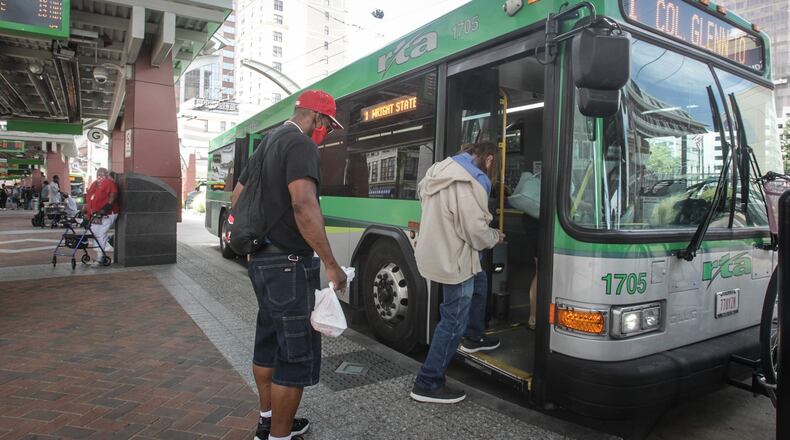The money is a big help during these tough economic times when the agency’s sales tax revenues have sharply declined and local bus ridership is about half of what was pre-COVID-19.
But ridership has rebounded a little and could soon increase because Montgomery County’s Workforce Development Department has partnered with the RTA to provide free bus passes to jobless workers in the county who receive unemployment benefits.
“Those who have suffered employment loss during the pandemic will be provided access to all RTA services to assist them in rebuilding their lives,” said RTA Board of Trustees President Sharon Hairston.
For the fourth year in a row, the Greater Dayton RTA has received funding from the Federal Transit Administration’s grants for buses and bus facilities program.
The RTA’s grant-award win streak from the program is unheard of nationally, and it has provided the agency with about $15.3 million to replace 30 diesel buses and five electric buses, said Bob Ruzinsky Greater Dayton RTA deputy chief executive officer.
“Statistically, nationwide, we’ve received over the five years just under 1% of the national funding,” he said. “That’s pretty impressive for Dayton, Ohio.”
Only 96 projects received grant funding across the nation, including just three in Ohio.
The pandemic budget woes
New buses save a lot of money in maintenance costs, and they provide a more comfortable and enjoyable rider experience, Ruzinsky said. The 12 new buses will be “clean-diesel” with very low emissions, officials said.
Over the last six years, the RTA has replaced its entire fleet using various grant dollars, which includes 120 diesel buses and about 45 electric buses, Ruzinsky said.
Currently, he said, the agency’s oldest buses were purchased in 2008 and 2009, and it’s very likely that when the vehicles are replaced, they will end up being used by another communities with much older fleets.
The RTA’s regular funding sources have been hammered by the coronavirus economic slowdown.
Last month, the RTA saw a roughly 15% decline in sales tax revenue, which lags about three months behind actual sales, Ruzinsky said. Larger reductions in collections are possible in coming months.
Normally, RTA passengers take about 30,000 trips each day. But since the outbreak, passenger traffic and revenues are down by more than half.
Ridership was down 54% in April, 49% in May and 36% in June, compared to 2019, agency data show.
Recently, bus ridership has increased slightly, and it could see a bump because Montgomery County’s workforce development department is offering free monthly RTA bus passes for county residents who receive unemployment insurance.
Free monthly passes will be available through the RTA’s mobile fare system Tapp Pay, which is accessible via the “Transit” app, which can be downloaded on Apple and Android smartphones.
In the week ending Aug. 1, more than 19,500 people in the county received continued unemployment benefits.
Montgomery County staff are in charge of approving and loading the passes onto smartphones, and jobless workers can contact Montgomery County’s Business Services at (937) 225-5627 or fill out the online form at https://bit.ly/FreeBusPass.
Financial situation
RTA’s financial situation has been helped by $75 million the agency has received from the CARES Act, which was the most recent coronavirus-rescue bill passed by federal lawmakers.
The RTA is extremely important to ensure citizens have transportation to access food, jobs and medical treatment, supplies and medicine, said U.S. Rep. Mike Turner (R-Dayton) at a Thursday press conference.
“RTA here is incredibly well managed, so they’re trusted by the federal transportation authority agencies,” Turner said. “They look to them and know they will accomplish exactly what they say they will and they are serving some of the neediest populations of our community.”
The RTA still faces long-term financial challenges because it has operated on the same local tax support since 1980 without seeking additional funds, said Greater Dayton RTA CEO Mark Donaghy.
In the last two decades, the agency has had to deal with rising costs and decreased state funding assistance, which has led to service reductions, he said.
The RTA is not going to be able to finance current service levels in the future without new revenue, Donaghy said.
A couple of months ago, Donaghy recommended that the RTA pursue a sale tax hike in November that asks voters for additional half cent levy.
But after a lengthy discussion, the RTA Board of Trustees decided this is not the right time to seek a referendum, given the challenging economic conditions.
“RTA will rely in the short term on CARES Act funding, designated to support the system during the pandemic,” Donaghy said. “Beyond that, we will be looking at ways to continue services that can be financed through currently available revenue streams for the foreseeable future.”
The RTA’s projected revenue loss is $5.7 million for 2020, and that is expected to grow to $8.3 million by 2024, officials said. The current sales tax of a half cent raised $39 million in 2019.
More than a year ago, the RTA began talking with county residents, its customers and community leaders about how it could improve services and help grow the region’s economy, Donaghy said.
Community feedback, he said, suggests that people want a redesigned model with increased bus frequency and improved service to high-growth employment areas.
About the Author


